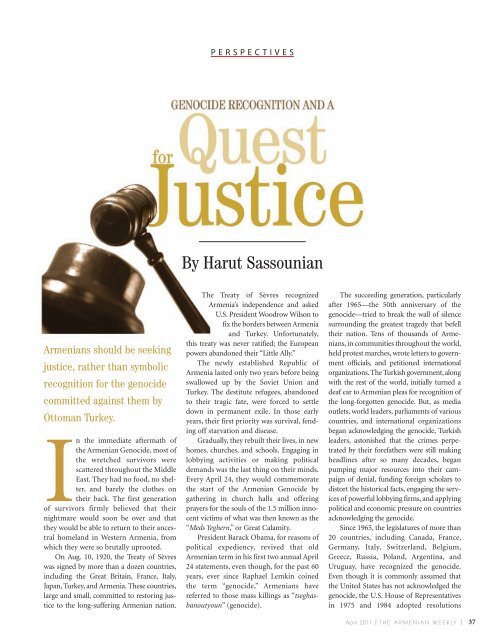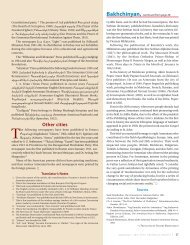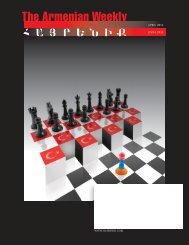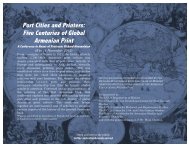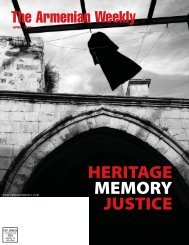Armenian Weekly April 2011 Magazine
Armenian Weekly April 2011 Magazine
Armenian Weekly April 2011 Magazine
Create successful ePaper yourself
Turn your PDF publications into a flip-book with our unique Google optimized e-Paper software.
PERSPECTIVESBy Harut Sassounian<strong>Armenian</strong>s should be seekingjustice, rather than symbolicrecognition for the genocidecommitted against them byOttoman Turkey.In the immediate aftermath ofthe <strong>Armenian</strong> Genocide, most ofthe wretched survivors werescattered throughout the MiddleEast. They had no food, no shelter,and barely the clothes ontheir back. The first generationof survivors firmly believed that theirnightmare would soon be over and thatthey would be able to return to their ancestralhomeland in Western Armenia, fromwhich they were so brutally uprooted.On Aug. 10, 1920, the Treaty of Sèvreswas signed by more than a dozen countries,including the Great Britain, France, Italy,Japan, Turkey, and Armenia. These countries,large and small, committed to restoring justiceto the long-suffering Arme nian nation.The Treaty of Sèvres recognizedArmenia’s independence and askedU.S. President Woodrow Wilson tofix the borders between Armeniaand Turkey. Unfortunately,this treaty was never ratified; the Europeanpowers abandoned their “Little Ally.”The newly established Republic ofArmenia lasted only two years before beingswallowed up by the Soviet Union andTurkey. The destitute refugees, abandonedto their tragic fate, were forced to settledown in permanent exile. In those earlyyears, their first priority was survival, fendingoff starvation and disease.Gradually, they rebuilt their lives, in newhomes, churches, and schools. Engaging inlobbying activities or making politicaldemands was the last thing on their minds.Every <strong>April</strong> 24, they would commemoratethe start of the <strong>Armenian</strong> Genocide bygathering in church halls and offeringprayers for the souls of the 1.5 million innocentvictims of what was then known as the“Meds Yeghern,” or Great Calamity.President Barack Obama, for reasons ofpolitical expediency, revived that old<strong>Armenian</strong> term in his first two annual <strong>April</strong>24 statements, even though, for the past 60years, ever since Raphael Lemkin coinedthe term “genocide,” <strong>Armenian</strong>s havereferred to those mass killings as “tseghasbanoutyoun”(genocide).The succeeding generation, particularlyafter 1965—the 50th anniversary of thegenocide—tried to break the wall of silencesurrounding the greatest tragedy that befelltheir nation. Tens of thousands of Arme -nians, in communities throughout the world,held protest marches, wrote letters to governmentofficials, and petitioned internationalorganizations. The Turkish government, alongwith the rest of the world, initially turned adeaf ear to <strong>Armenian</strong> pleas for recognition ofthe long-forgotten genocide. But, as mediaoutlets, world leaders, parliaments of variouscountries, and international organizationsbegan acknowledging the genocide, Turkishleaders, astonished that the crimes perpetratedby their forefathers were still makingheadlines after so many decades, beganpumping major resources into their campaignof denial, funding foreign scholars todistort the historical facts, engaging the servicesof powerful lobbying firms, and applyingpolitical and economic pressure on countriesacknowledging the genocide.Since 1965, the legislatures of more than20 countries, including Canada, France,Germany, Italy, Switzerland, Belgium,Greece, Russia, Poland, Argentina, andUruguay, have recognized the genocide.Even though it is commonly assumed thatthe United States has not acknowledged thegenocide, the U.S. House of Representativesin 1975 and 1984 adopted resolutions<strong>April</strong> <strong>2011</strong> | THE ARMENIAN WEEKLY | 37


